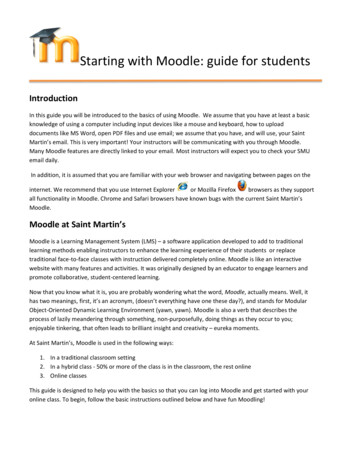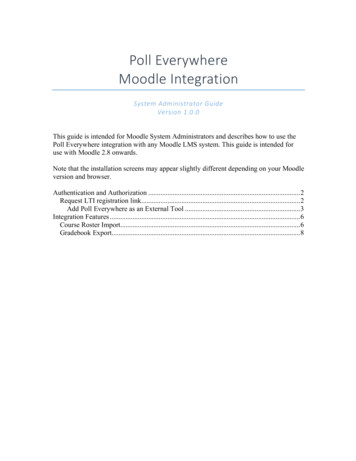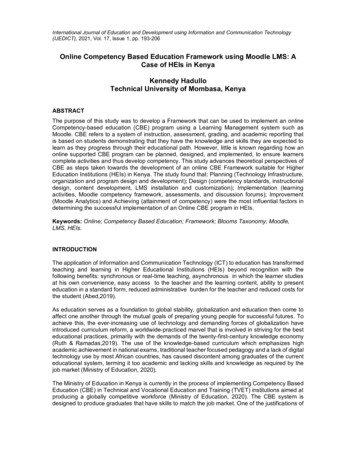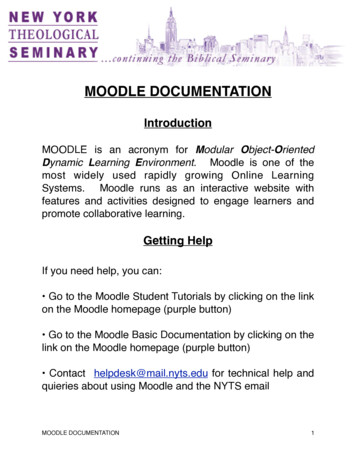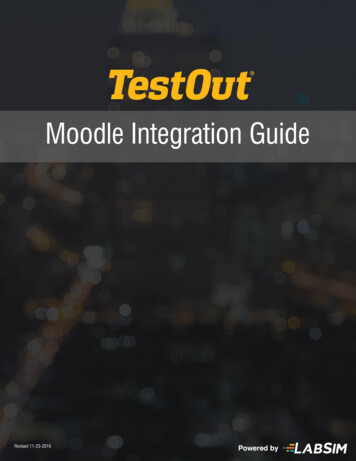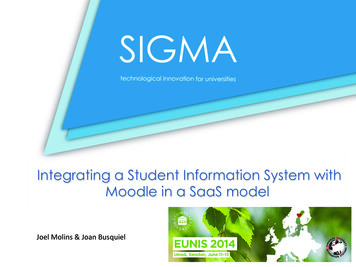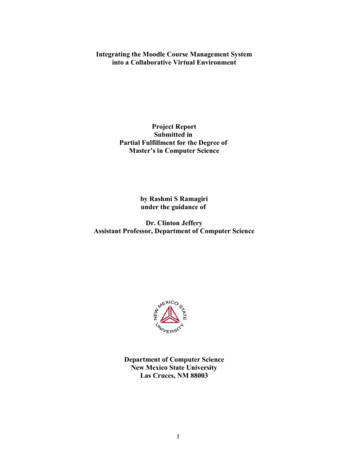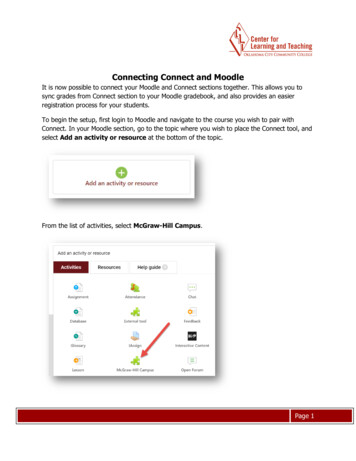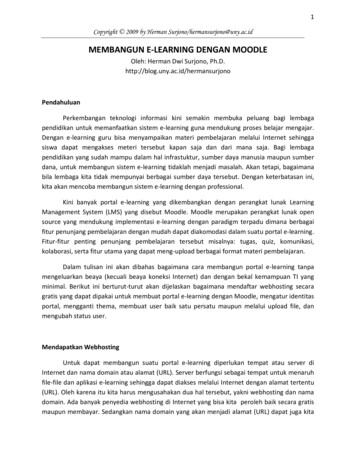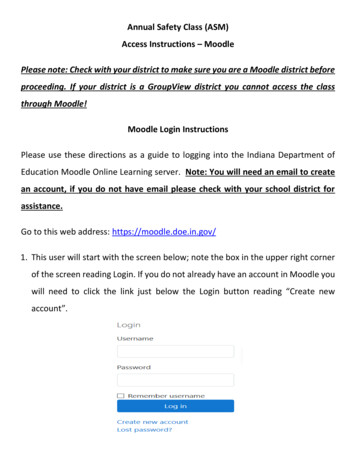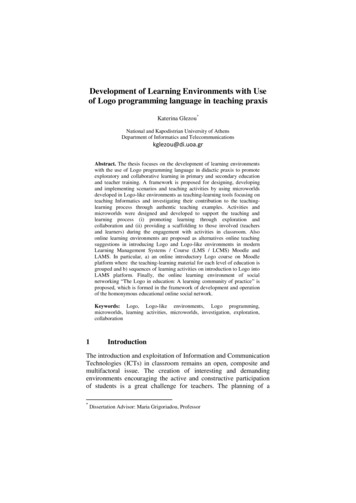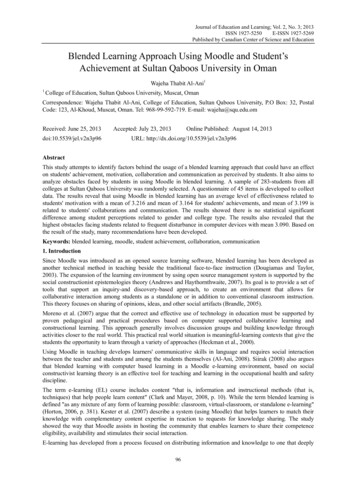
Transcription
Journal of Education and Learning; Vol. 2, No. 3; 2013E-ISSN 1927-5269ISSN 1927-5250Published by Canadian Center of Science and EducationBlended Learning Approach Using Moodle and Student’sAchievement at Sultan Qaboos University in OmanWajeha Thabit Al-Ani11College of Education, Sultan Qaboos University, Muscat, OmanCorrespondence: Wajeha Thabit Al-Ani, College of Education, Sultan Qaboos University, P.O Box: 32, PostalCode: 123, Al-Khoud, Muscat, Oman. Tel: 968-99-592-719. E-mail: wajeha@squ.edu.omReceived: June 25, 2013doi:10.5539/jel.v2n3p96Accepted: July 23, 2013Online Published: August 14, 2013URL: http://dx.doi.org/10.5539/jel.v2n3p96AbstractThis study attempts to identify factors behind the usage of a blended learning approach that could have an effecton students' achievement, motivation, collaboration and communication as perceived by students. It also aims toanalyze obstacles faced by students in using Moodle in blended learning. A sample of 283-students from allcolleges at Sultan Qaboos University was randomly selected. A questionnaire of 45 items is developed to collectdata. The results reveal that using Moodle in blended learning has an average level of effectiveness related tostudents' motivation with a mean of 3.216 and mean of 3.164 for students' achievements, and mean of 3.199 isrelated to students' collaborations and communication. The results showed there is no statistical significantdifference among student perceptions related to gender and college type. The results also revealed that thehighest obstacles facing students related to frequent disturbance in computer devices with mean 3.090. Based onthe result of the study, many recommendations have been developed.Keywords: blended learning, moodle, student achievement, collaboration, communication1. IntroductionSince Moodle was introduced as an opened source learning software, blended learning has been developed asanother technical method in teaching beside the traditional face-to-face instruction (Dougiamas and Taylor,2003). The expansion of the learning environment by using open source management system is supported by thesocial constructionist epistemologies theory (Andrews and Haythornthwaite, 2007). Its goal is to provide a set oftools that support an inquiry-and discovery-based approach, to create an environment that allows forcollaborative interaction among students as a standalone or in addition to conventional classroom instruction.This theory focuses on sharing of opinions, ideas, and other social artifacts (Brandle, 2005).Moreno et al. (2007) argue that the correct and effective use of technology in education must be supported byproven pedagogical and practical procedures based on computer supported collaborative learning andconstructional learning. This approach generally involves discussion groups and building knowledge throughactivities closer to the real world. This practical real world situation is meaningful-learning contexts that give thestudents the opportunity to learn through a variety of approaches (Heckman et al., 2000).Using Moodle in teaching develops learners' communicative skills in language and requires social interactionbetween the teacher and students and among the students themselves (Al-Ani, 2008). Siirak (2008) also arguesthat blended learning with computer based learning in a Moodle e-learning environment, based on socialconstructivist learning theory is an effective tool for teaching and learning in the occupational health and safetydiscipline.The term e-learning (EL) course includes content "that is, information and instructional methods (that is,techniques) that help people learn content" (Clark and Mayer, 2008, p. 10). While the term blended learning isdefined "as any mixture of any form of learning possible: classroom, virtual-classroom, or standalone e-learning"(Horton, 2006, p. 381). Kester et al. (2007) describe a system (using Moodle) that helps learners to match theirknowledge with complementary content expertise in reaction to requests for knowledge sharing. The studyshowed the way that Moodle assists in hosting the community that enables learners to share their competenceeligibility, availability and stimulates their social interaction.E-learning has developed from a process focused on distributing information and knowledge to one that deeply96
www.ccsenet.org/jelJournal of Education and LearningVol. 2, No. 3; 2013engages learners in sophisticated interactions through communities that transcend geographic barriers (Liebowitzand Frank, 2011). This gives EL the benefit of exceeding the process of delivering knowledge. It strives tochange students' behaviors, and increases content effectiveness. Though EL can be defined as "the acquisitionand use of knowledge distributed and facilitated primarily by electronic means" (Waight et al., 2002, p. 492),Liebowitz and Frank (2011) state some of the other characteristics of e-learning. These characteristics are relatedto the root of the pedagogical framework of EL that has evolved from behaviorist theory in the late 1950s and1960s to encompass a broader definition of "learning" that includes collaborative and constructivist paradigms oflearning, including opportunities for practice with feedback, social collaboration, tailored instruction, simulationand games (Clark and Mayer, 2008).In order to assure the transition to an e-learning environment, Liebowitz and Frank (2011) state that manysignificant challenges need to be faced such as:1) Create and nurture acknowledge-sharing culture.2) Support learners in adapting to change.3) Design training and development to achieve the mission and advance competence.4) Design education to prepare students to achieve success.5) Develop learners to ask appropriate questions.6) Provide needed relevant information just enough, just in time.Because of these challenges of EL, learners are required to be more disciplined, self-motivated, andself-regulated than in a traditional classroom environment. Clark and Mayer (2008) add that e-learning will alsoincreasingly make use of the unique technological features that can support simulations and good opportunitiesto learn. This technique will encourage learners to build mental models and problem solving skills relies on bothcognitive and metacognitive skills. The advantage of this skill is to make learners more aware and to controltheir own learning process and increase their retention capacity (Liebowitz and Frank, 2011). Instructionaldesign is considered as a ground theory for EL. It combines between the entire set of events and materials thataffect learners for the purpose of accomplishing "a particular learning goal". This process must be carefully andsystematically planned. Also, according to behavior learning objectives, if there is no teacher to instruct a personat the time, the ability to provide feedback can be constrained by available technology. Since EL requires highlymotivated learners, it needs to increase the emphasis on a teaching presence in self-paced and highly interactiveformats such as facilitated discussion or interactive environment such as wikis and blogs (Beldarrain, 2006).1.1 Problem StatementSince 2005, the Learning Management System (LMS) Moodle has been deployed as a major piece of technologyat Sultan Qaboos University (SQU) for a blended learning approach to enhance students’ achievement. Manycourses have adopted this approach and the adoption rate reached 1362 in fall 2011. Blended learning isendorsed as a strategy that helps to create a more integrated approach for both instructors and learners. Since thisis a new approach and method, it has obviously brought some changes in teaching and learning. To examine this,research needs to be done to measure its effectiveness on students' learning outcomes and achievements.Therefore, this study attempts to find out the effectiveness of creating blended learning using Moodle onstudents' learning achievements, motivation, and collaboration and communication.1.2 Research ObjectiveSince this research aims to determine the effectiveness of a blended learning approach using Moodle and todetermine students’ achievement at SQU in Oman, therefore, it strives to achieve the following objectives:1) To investigate to what extent a blended learning approach using Moodle could determine students’achievement in SQU in Oman.2) To examine the dominant Moodle factors that lead to students’ achievement.3) To determine the obstacles facing blended learning approach using Moodle.4) To know if there is any relationship between the blended learning approach using Moodle and these obstacles.1.3 Significance of the StudyThis study might provide insights that encourage SQU faculty members to utilize the emergent technology byusing Moodle to improve the quality of teaching to enhance student learning achievements. Also, it may raiseawareness among faculty members about the benefits of blended learning and its effectiveness on student97
www.ccsenet.org/jelJournal of Education and LearningVol. 2, No. 3; 2013learning achievements. The study findings will be useful in helping decision makers to determine the need fortransforming the learning environment from face to face to blended learning in the University. It is expected thatusing Moodle will increase students' learning responsibility through social interaction (Bruner, 1990).In addition, within the term of distance education, using Moodle will make the learning environment moremeaningful through students' reflections and through developing their own procedures and techniques. Moreover,this research contributes to the relevant knowledge on ICT acceptance among students and their learningprogress in the Omani context. It helps in creating opportunities by allowing students to participate and shareideas with their peers at the University. Last but not least, it assists instructors, lecturers and management tomonitor students’ achievement when it comes to Moodle usage.1.4 Theoretical FrameworkThe use of socio-constructivist pedagogy has been identified as learning theory in the digital age whereeducators and students jointly explore, inquire, critique, and build their own knowledge effectively andefficiently (Lasic, 2011). Therefore the theoretical framework of this study is built on the constructivist theorythat is about people knowing the world through their framework and helping them to organize as well asinterpret their perceptions (Sackeny and Mergel, 2007).1.5 Conceptual FrameworkFigure 1. Research conceptual frameworkFigure 1 presents the research conceptual framework using Moodle for blended learning to enhance students'learning achievement. The conceptual research framework was a developed base theory, a literature review andfindings that stated that Moodle is e-learning software for learning management that could help teachers oreducators to create interaction and collaboration with the course content. It is believed that, when Moodle is used,it helps blended learning to take place in mixing different learning environments where both Moodle andblended learning lead to students' learning achievement, learning motivation, collaboration and communication.1.6 Related Literature1.6.1 DefinitionsMoodle stands for “Modular Object-Oriented Dynamic Learning Environment. “Moodle has already become aterm of its own synonymous with a software package designed to help educators create quality online instruction.It was the brainchild of Martin Dougiamas. It is designed to help educators create quality online instruction"(Brandle, 2005, p. 16). Besides, Moodle is used interchangeably as a Learning Management System.Blended learning is defined as “a combination of various instructional modalities intertwined with synchronousand/or asynchronous web-based technologies to facilitate interactive and reflective individual and collectivelearning" (Lupshenyuk and Adams, 2009, p. 428).98
www.ccsenet.org/jelJournal of Education and LearningVol. 2, No. 3; 20131.6.2 The Relationship between Blended Learning and MoodleBlended learning is commonly defended as an integration of traditional face-to-face and online approaches toinstruction. Liebowitz and Frank (2011) define blended learning as a hybrid of traditional face-to-face and onlinelearning instruction occurring both in classrooms and online and where the online component becomes a naturalextension of traditional learning.Research has proven that Moodle or (LMS) usage in the classroom enhances learning beyond the classroom forboth teachers and learners (de Vega & McAnally-Salas, 2010; Govender, 2009; Georgouli, Skalkidis & Guerreiro2008; Harman, 2007; Henderson 2010).Additionally, it is proven that blended learning takes place when Moodle or a LMS is deployed. Besides, theapplication of Moodle or LMS, which was built on the Sociocultural-Constructivist learning model of (Melton,2008), is believed to create a student-centered approach where students and instructors are both engaged andactive in the classroom and use constructive learning activities.1.6.3 Blended Learning and e-Learning in TeachingThe Al-Saleem et al. (2010) study was an attempt to investigate the effect of using blended learning on teachingEnglish as a foreign language (EFL) on students' oral skills. The result of the study proved that blended learningenhanced significantly the EFL oral skills of the students of the experimental group due to the teachingprocedures. This result is explained that blended learning exposed students to unlimited interaction with alanguage user, using sense of hearing, seeing and interacting. Also, the experimental groups were more interestedin learning oral skills and that had a positive improvement in their achievements.In a study of the importance of embedding e-learning in traditional universities, MacKeogh and Fox (2009)examine the possibility of linking e-learning with the achievement of strategic goals of traditional Irishuniversities (teaching is on-campus and face-to-face). This study examined the drives and barriers that increaseor decrease motivation to engage in e-learning, and thus provided some insights into the challenges ofembedding e-learning in higher education. The results of the study show that many academic staff continue toprefer traditional lectures, and are skeptical about the potential for student learning in online settings. Otherobstacles related to extrinsic factors in terms of lack of time and support served to decrease motivation. Therewere also fears of loss of academic control to central administration. The study concluded with the importance ofraising awareness and the establishment of effective support structures for embedding e-learning.A study was conducted by Ellis et al. (2007) on the characteristics that shape a model to manage e-learning in alarge predominantly campus-based university. The study illustrated key aspects of the management modelproviding insights into developing meaningful e-learning resources for students. The findings of the studyrevealed several challenges for quality improvement at the level of both course and university that (mainly due tothe fact that e-learning complements the face-to-face learning experience) require a relational and embeddedapproach.With regard to the motivational factors that influence the acceptance of a Moodle using Technology AcceptanceModel (TAM), a study was conducted by Sanchez and Hueros (2010) that aimed to improve understanding of themotivational factors behind students’ satisfaction or dissatisfaction with the web-based learning platform Moodle.228 students were surveyed. The results showed that technical support directly perceived usefulness. Also,Moodle usage was directly influenced by perceived ease of use and attitude.Bhattacharya and Sharma (2007) showed India's' extensive efforts to invest in information and communicationtechnology (ICT) to enhance quality human resources in higher education in their developing nation. The studyshowed the challenges of traditional face-to-face education vis-à-vis e-learning in India. The challenges werelisted and suggestions for management of e-learning processes by institutes which intend to venture intoe-learning were enumerated. Also the study advocates the urgency for traditional institutions to invest in ICT.This will provide e-instruction for the delivery of knowledge by riding the information super highway.With regard to successful blended learning, Mitchell and Honore (2007) highlight the factors that need to beconsidered when a blended learning solution is used in a group environment. The study showed that theimportance of human behavioral factors regarding content and tool selection is very important. The role of groupdynamics in achieving the learning outcomes also needs to be considered. Besides the learning experience, otherlearning methods experienced on the course are influenced partly by students' expectations and preferences.1.6.4 Moodle for Learning EnhancementPerkins and Pfaffman's (2006) study aims to show the benefits of using a Course Management System (CMS) to99
www.ccsenet.org/jelJournal of Education and LearningVol. 2, No. 3; 2013enable teachers to easily post assignments, lesson plans, announcements and course documents. The studyhighlighted the advantages of using Moodle as a free open-source software program that not only provides a setof features similar to those of its proprietary competitors, it is often easier to use. The study describes howMoodle has improved and enhanced student performance by promoting and organizing communication amongparents, students, teachers, administrators, and the community. Using CMS can help to reduce distractions androadblocks to science learning and improve communication with colleagues, students, and parents.With regards to the design of a competitive and collaborative learning strategy, Regueras et al. (2011) found outthat using the Moodle Wiki encourages the development of students' inquiry, documentation and critical analysisskills and raises the level of involvement and communication between students and teachers. WhileKonstantinidis et al. (2011) argue that the rationale behind the utilization of Moodle for the facilitation of ablended learning approach in the informatics departments is the help it offers to a variety of instructor andstudent needs.From the above reviewed literature, it can be concluded that transferring to an e-learning environment is oneaspect of restructuring learning strategies by showing more concern for learners, and giving them more space foreffective involvement in the learning process. This is done through using the open software e-learning platformMoodle. Regarding the blended learning in higher education, the Lopez-Perez et al. (2011) study shows that theuse of blended learning has a positive effect on reducing dropout rates and in improving exam marks. Moreover,the students' perceptions of blended learning are interrelated with their final marks depending on the blendedlearning activities and on the students' age, background and class attendance rate.1.6.5 Supported ModelsLooking at the effectiveness of using Moodle in teaching, many models have been developed. Woltering et al.(2009) show a module that enhances students' motivation and satisfaction and overcomes problems namedBlended Problem-Based Learning (BPBL). A total of 185 third-year students and 14 tutors took part in this study.The results show motivation, subjective learning gains and satisfaction were all awarded significantly higherratings by BPBL students compared with students' learning by traditional problem-based learning. The BPBLmodule also improves cooperation during self-directed learning. Another blended Model was developed byMcLuckie et al. (2009) using the open-source e-learning platform Moodle. The model was used to supportstudents' and professionals' learning when face-to-face contact time between students and tutors wassignificantly is reduced. The study results show that the use of collaborative and peer-assessed tools likee-portfolios, newsletters, discussion forums, Wikis and group puzzles can be used as means to satisfy demands;and that this approached reflects the socially constructivist principles of learning.100
www.ccsenet.org/jelJournal of Education and LearningVol. 2, No. 3; 2013Figure 2. Blended Learning 4 Level Models and Online LearningFigure 2 complements this research on blended learning using Moodle. It supports the idea and the relationshipof blended learning with e-learning. It shows that blended learning is effective and efficient when it is appliedonline or as Moodle. The levels in figure 2 indicate that blended learning with the online learning integrationfacilitates learning, communication and provides e-material to support learning. The 4 blended learning modelsupgrades instruction and help students’ engagement in the classroom, assignments, collaboration, supervision ofprojects and development.1.6.6 Challenges of Blended Learning Using MoodleHigher education institutions face many challenges in teaching as they increasingly move to blended and fullyonline environments. Banerjee (2011) indicates that student satisfaction with blended learning depends largelyon the challenges presented by the subject matter, the degree to which self directed learning and problem solvingare required and the effectiveness of the chosen pedagogies by which face-to-face and online methods arecombined. Also blended environments, which provide sustained connections with teachers and peers arepreferred by increasing the number of students. Shivetts (2011) mentions that student motivation is a majorfactor for e-learning and blended learning success. This success is heavily related to course layout andaccessibility. Showing the effectiveness of using Moodle in blended learning is very helpful in assessingstudents' vocabulary acquisition. Jia et al. (2012) customized Moodle to build individualized vocabulary reviewand assessment functions of English instruction. Within this blended learning environment, students'performance in an experimental class in the ordinary, and especially vocabulary, examinations throughout theschool term gradually improved and exceeded that of the control class.Seung-Won and Lim (2007) present a conceptual framework for Strategic Blended-Learning and PerformanceSolution (SBLPS). This model was designed to improve learning performance solutions derived from the goalsand needs of their organization. Deeb (2007) shows that involving students in web-blended learning activitiessupport significant improvement in their academic performance, and advancement in their collective andintuitive knowledge at both social and technical levels.1.7 Research QuestionsThe study intended to answer the following questions:1) What is/are the dominant Moodle factor(s) that lead mostly to students’ achievements as perceived by the101
www.ccsenet.org/jelJournal of Education and LearningVol. 2, No. 3; 2013students?2) What are the obstacles faced by students in the blended learning approach using Moodle in learning?3) Are there any statistically significant relationships between the students’ usage of Moodle in learning and theobstacles facing them?2. MethodThis study attempted to investigate university students’ uses of open source learning software (Moodle) inlearning in the way that activated their achievements. This study looks to Moodle as software that helps teachersat SQU to create an effective blended learning environment. Also, it is used as a support tool to help students toexperience and build knowledge through exchanging ideas and information among themselves and with theirteacher.2.1 Data Collection ProcedureThe research population consisted of students from SQU in Oman. SQU is the national governmental universityin Sultanate of Oman, established in 1986. It consists of nine colleges and the English Language Center(www.squ.edu.om). It also has a large Center for Educational Technology as a service teaching facilitation center.Throughout its history, the university has been concerned about quality assurance in its academic program. Inorder to accomplish this, SQU has developed a strategic policy that attempts to enhance the university learningenvironment by equipping all teaching rooms and offices with computer facilities and services. This studyexamined the uses of Moodle at SQU since its first introduction in 2005. The number of e-learning courses hasincreased rapidly and has reached 1362 courses, 46% of the total 2953 courses offered at SQU at the time thisresearch was conducted in the Spring Semester 2012. The e-learning courses are offered at different levels andare multi service courses that meet students' needs and interests. However, not all courses were actively usingMoodle at the time of research data collection. Thus, a random sample from the active courses was chosen. Atotal of 18 instructors representing 18 courses that use blended learning using Moodle in teaching agreed todistribute the questionnaire to their students during regular classes. The courses were chosen with considerationto college type (Humanities and Sciences). An average number of 15-16 students from each course were askedvoluntarily to participate in the study.2.2 SampleA sample of 283-students from all colleges at SQU was randomly selected in the Spring Semester 2012. Thissample represents the students who are using Moodle as a type of blended learning on the courses. Thedescription of the study sample is shown in table 1.Table 1. The demographic description of the study 6558.3%Sciences11841.7%Inside campus10537.1%Outside campus17862.9%283100.0%Total2.3 Research InstrumentThe main instrument of this study was a questionnaire developed by generating a list of factors derived from theliterature (Sambrook, 2003; Brandle, 2005; and Mazza and Botturi, 2007). These factors are learningachievement, learning motivation, and students’ collaboration and communication learning skills. Beside thesestatements, the questionnaire included a list of obstacles (14-items) that face students in using Moodle inlearning.The instrument for the study was validated by a group of specialists in the area of educational learning andinstruction, educational technology, educational administration, and education psychology in the College of102
www.ccsenet.org/jelJournal of Education and LearningVol. 2, No. 3; 2013Education at SQU.A Liker-type scale ranging from 1 very low to 5 very high was used to measure students’ responses on the usesof Moodle in learning. A theoretical mean of 3.00 (mid-point of the scale) was determined as the criterion tojudge the means. A list of 14 obstacles facing students in using Moodle in learning was developed on a scalefrom 0 the lowest to 5 the highest degree.To determine the reliability of the instrument, a random sample of 30 students was selected and theChronbach-Alpha was found to be 0.961 on the total items, 0.912 for learning achievement, 0.902 for learningmotivation and 0.903 for students’ collaboration and communication.3. ResultsThis study attempted to identify the factors that affected student achievement during their use of the open sourcelearning software Moodle. These factors are distributed in three domains as shown in table 2.Table 2. Means and Standard Deviation (SD) and Rank of Study domainsDomainsMeansSDRankStudents' Learning Achievement (LA)3.164.6533Students' Learning Motivation (LM)3.216.8001Students' Collaboration and Communication (SCC)3.199.7542Total3.188.651The result of the first question reveals that using Moodle in learning is around the average level of effectivenessaccording to the theoretical mean of 3.00 as a criterion to judge the result. These means ranged from 3.216, thehighest mean of the distribution for using Moodle makes students more motivated toward learning, followed bystudent collaboration and communication 3.199. Finally, students’ learning achievement is rated at 3.164.The result of the student responses (Appendix I) shows that students look at Moodle as a learning tool thatallows them more freedom in choosing a suitable time for doing their homework (3.69). The blended learningapproach using Moodle also helps students to develop their learning skills (3.46) and be more self regulated(3.31) in searching for new scientific information (3.42). Looking at the results of the learning motivationdomain, students find the blended learning approach using Moodle interesting in tracking lecture notes andreading materials (3.28). In addition, students feel that using Moodle helps them in developing positive attitudestoward course subjects (3.30).With reference to the student collaboration and communication domain, students explained that using Moodlemade their lecture notes (3.91) and develop their skills in browsing throughout websites searching forinformation (3.73).Also, the results in table 3 show that there are statistically significant differences at (α 0.05) between the meanof students’ responses related to gender in the collaboration and communication domain in favor females (3.303)compared with males (3.103).Table 3. The Result of t-test in testing study 9.61587Inside campus1053.1689.68163.096.924Outside campus1783.1612.63844103(2-tailed)
www.ccsenet.org/jelLMSCCJournal of Education and LearningVol. 2, No. 3; ties1653.1910.79522Sciences1183.2507.81067Inside campus1053.2160.81965Outside 682.80507Inside campus1053.2275.74610Outside .243*.026.585.559.485.628*S
analyze obstacles faced by students in using Moodle in blended learning. A sample of 283-students from all colleges at Sultan Qaboos University was randomly selected. A questionnaire of 45 items is developed to collect data. The results reveal that using Moodle in blended learning has an average level of effectiveness related to
